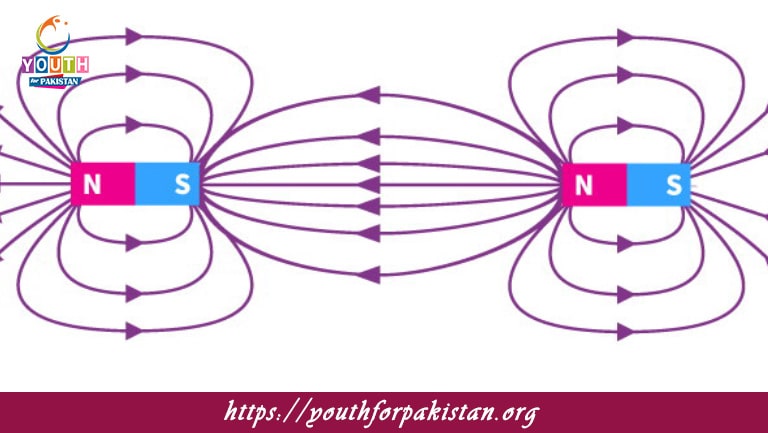Magnetic Field MDCAT MCQs with Answers

Welcome to the Magnetic Field MDCAT MCQs with Answers. In this post, we have shared Magnetic Field Multiple Choice Questions and Answers for PMC MDCAT 2024. Each question in MDCAT Physics offers a chance to enhance your knowledge regarding Magnetic Field MCQs in this MDCAT Online Test.
Magnetic Field MDCAT MCQs Test Preparations
The SI unit of the magnetic field is:
a) Ampere
b) Tesla
c) Weber
d) Henry
The direction of the magnetic field around a current-carrying conductor can be determined using:
a) Ohm’s Law
b) Faraday’s Law
c) Right-hand rule
d) Lenz’s Law
The magnetic field inside a long solenoid is:
a) Zero
b) Uniform and constant
c) Non-uniform
d) Radially outward
The force experienced by a charged particle moving perpendicular to a magnetic field is called:
a) Electric force
b) Gravitational force
c) Magnetic Lorentz force
d) Electrostatic force
The force on a current-carrying wire in a magnetic field is proportional to:
a) The current and the length of the wire
b) The temperature
c) The resistance of the wire
d) The area of cross-section of the wire
The magnetic flux through a surface is maximum when:
a) The surface is perpendicular to the magnetic field
b) The surface is parallel to the magnetic field
c) The magnetic field is zero
d) The magnetic field is variable
The direction of the magnetic field due to a straight current-carrying conductor is:
a) Along the direction of the current
b) Perpendicular to the direction of the current
c) Parallel to the direction of the current
d) Radial from the conductor
Ampere’s Circuital Law relates the magnetic field around a closed loop to:
a) Electric potential
b) Electric field
c) Electric current passing through the loop
d) Magnetic flux through the loop
The magnetic field inside a hollow conductor carrying current is:
a) Zero
b) Uniform
c) Varies with distance from the center
d) Increases with the current
The magnetic field at the poles of a bar magnet is:
a) Zero
b) Constant in magnitude
c) Decreases with distance
d) Uniform and equal in all directions
The principle of a moving coil galvanometer is based on:
a) Ohm’s Law
b) Faraday’s Law
c) Ampere’s Law
d) Magnetic Lorentz force
A magnetic field line is:
a) A closed loop
b) A straight line
c) A curve
d) An open line
The force on a charged particle in a magnetic field is zero when:
a) The particle is stationary
b) The particle is moving parallel to the field
c) The particle is moving perpendicular to the field
d) The magnetic field is zero
The magnetic field inside a toroid is:
a) Zero
b) Uniform
c) Radially outward
d) Decreases with radius
The magnetic force between two parallel current-carrying wires is:
a) Attractive if currents are in the same direction
b) Repulsive if currents are in opposite directions
c) Attractive if currents are in opposite directions
d) Zero if currents are equal
The magnetic field at a point due to a magnetic dipole decreases with:
a) Distance squared
b) Distance to the power of 3
c) Distance to the power of 4
d) Distance to the power of 5
The unit of magnetic flux is:
a) Weber
b) Henry
c) Tesla
d) Ampere
The magnetic field due to an infinite straight current-carrying wire decreases with:
a) Distance squared
b) Distance to the power of 2
c) Distance to the power of 3
d) Distance
The torque experienced by a current loop in a magnetic field is maximum when:
a) The plane of the loop is parallel to the field
b) The plane of the loop is perpendicular to the field
c) The loop is at an angle of 45 degrees to the field
d) The loop is not in the field
The Earth’s magnetic field is primarily:
a) Dipolar
b) Quadrupolar
c) Octupolar
d) Complex and irregular
The magnetic field inside a current-carrying solenoid is:
a) Zero
b) Uniform and parallel to the axis
c) Radially outward
d) Varies with distance from the axis
The Biot-Savart Law is used to calculate:
a) Electric field
b) Magnetic field due to a current element
c) Gravitational force
d) Electric potential
The force between two magnetic poles is inversely proportional to:
a) The distance between the poles
b) The square of the distance between the poles
c) The product of the pole strengths
d) The sum of the pole strengths
The magnetic field due to a circular current loop is maximum at:
a) The center of the loop
b) At the edge of the loop
c) At a point inside the loop but away from the center
d) At a point outside the loop
The right-hand rule for a solenoid tells us that the magnetic field:
a) Is in the direction of the thumb
b) Is in the direction of the curled fingers
c) Is in the direction opposite to the thumb
d) Is in the direction of the current
A galvanometer can be converted into an ammeter by:
a) Adding a high resistance in parallel
b) Adding a low resistance in series
c) Adding a low resistance in parallel
d) Removing the coil
The principle of operation of a transformer is based on:
a) Faraday’s Law of Electromagnetic Induction
b) Ampere’s Law
c) Gauss’s Law
d) Lenz’s Law
Magnetic field lines can never:
a) Cross each other
b) Form closed loops
c) Be parallel to each other
d) Be perpendicular to the direction of the current
The magnetic field at a point inside a solenoid is affected by:
a) The current passing through the solenoid
b) The length of the solenoid
c) The diameter of the solenoid
d) The number of turns per unit length
The magnetic field due to a current-carrying wire is strongest:
a) At the wire’s surface
b) At a distance far from the wire
c) At a distance directly proportional to the current
d) In a direction opposite to the current
The magnetic flux is defined as:
a) The product of the magnetic field and the area perpendicular to it
b) The product of the magnetic field and the current
c) The product of the magnetic field and the charge
d) The product of the magnetic field and the time
The magnetic field inside a bar magnet is:
a) Radial outward from the north pole
b) Radial inward to the south pole
c) Uniform and constant
d) From the north pole to the south pole inside the magnet
The force on a moving charge in a magnetic field is maximum when:
a) The velocity of the charge is zero
b) The velocity of the charge is parallel to the magnetic field
c) The velocity of the charge is perpendicular to the magnetic field
d) The magnetic field is zero
The unit of magnetic permeability is:
a) Tesla
b) Henry per meter
c) Weber
d) Ampere per meter
The force between two parallel wires carrying current is directly proportional to:
a) The distance between the wires
b) The square of the distance between the wires
c) The product of the currents
d) The reciprocal of the currents
The magnetic field due to a current-carrying loop at its center is:
a) Zero
b) Maximum
c) Decreases with distance
d) Independent of the current
The magnetic field lines in a magnetic dipole are:
a) Closed loops from the north to the south pole
b) Open lines from the north pole to infinity
c) Open lines from the south pole to infinity
d) Radial lines
A magnetic field can be produced by:
a) A stationary electric charge
b) A moving electric charge
c) A stationary magnetic dipole
d) A non-moving magnetic dipole
If you are interested to enhance your knowledge regarding Physics, Chemistry, Computer, and Biology please click on the link of each category, you will be redirected to dedicated website for each category.





